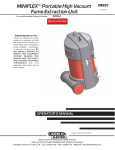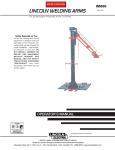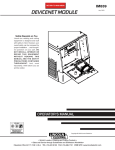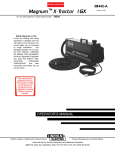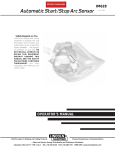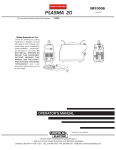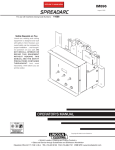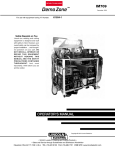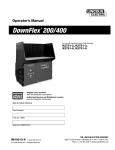Download Lincoln Electric IM959 User's Manual
Transcript
ARC® 35 RETURN TO MAIN MENU COOL For use with machines having Code Numbers: IM959 January, 2010 11427 Safety Depends on You Lincoln arc welding and cutting equipment is designed and built with safety in mind. However, your overall safety can be increased by proper installation ... and thoughtful operation on your part. DO NOT INSTALL, OPERATE OR REPAIR THIS EQUIPMENT WITHOUT READING THIS MANUAL AND THE SAFETY PRECAUTIONS CONTAINED THROUGHOUT. And, most importantly, think before you act and be careful. N80 IP 21S IEC 60974-2 OPERATOR’S MANUAL Copyright © Lincoln Global Inc. ¤ • World's Leader in Welding and Cutting Products • • Sales and Service through Subsidiaries and Distributors Worldwide • Cleveland, Ohio 44117-1199 U.S.A. TEL: 216.481.8100 FAX: 216.486.1751 WEB SITE: www.lincolnelectric.com i i SAFETY WARNING CALIFORNIA PROPOSITION 65 WARNINGS Diesel engine exhaust and some of its constituents are known to the State of California to cause cancer, birth defects, and other reproductive harm. The Above For Diesel Engines The engine exhaust from this product contains chemicals known to the State of California to cause cancer, birth defects, or other reproductive harm. The Above For Gasoline Engines ARC WELDING CAN BE HAZARDOUS. PROTECT YOURSELF AND OTHERS FROM POSSIBLE SERIOUS INJURY OR DEATH. KEEP CHILDREN AWAY. PACEMAKER WEARERS SHOULD CONSULT WITH THEIR DOCTOR BEFORE OPERATING. Read and understand the following safety highlights. For additional safety information, it is strongly recommended that you purchase a copy of “Safety in Welding & Cutting - ANSI Standard Z49.1” from the American Welding Society, P.O. Box 351040, Miami, Florida 33135 or CSA Standard W117.2-1974. A Free copy of “Arc Welding Safety” booklet E205 is available from the Lincoln Electric Company, 22801 St. Clair Avenue, Cleveland, Ohio 44117-1199. BE SURE THAT ALL INSTALLATION, OPERATION, MAINTENANCE AND REPAIR PROCEDURES ARE PERFORMED ONLY BY QUALIFIED INDIVIDUALS. FOR ENGINE powered equipment. 1.h. To avoid scalding, do not remove the radiator pressure cap when the engine is hot. 1.a. Turn the engine off before troubleshooting and maintenance work unless the maintenance work requires it to be running. ____________________________________________________ 1.b. Operate engines in open, well-ventilated areas or vent the engine exhaust fumes outdoors. ____________________________________________________ 1.c. Do not add the fuel near an open flame welding arc or when the engine is running. Stop the engine and allow it to cool before refueling to prevent spilled fuel from vaporizing on contact with hot engine parts and igniting. Do not spill fuel when filling tank. If fuel is spilled, wipe it up and do not start engine until fumes have been eliminated. ____________________________________________________ 1.d. Keep all equipment safety guards, covers and devices in position and in good repair.Keep hands, hair, clothing and tools away from V-belts, gears, fans and all other moving parts when starting, operating or repairing equipment. ____________________________________________________ 1.e. In some cases it may be necessary to remove safety guards to perform required maintenance. Remove guards only when necessary and replace them when the maintenance requiring their removal is complete. Always use the greatest care when working near moving parts. ___________________________________________________ 1.f. Do not put your hands near the engine fan. Do not attempt to override the governor or idler by pushing on the throttle control rods while the engine is running. ELECTRIC AND MAGNETIC FIELDS may be dangerous 2.a. Electric current flowing through any conductor causes localized Electric and Magnetic Fields (EMF). Welding current creates EMF fields around welding cables and welding machines 2.b. EMF fields may interfere with some pacemakers, and welders having a pacemaker should consult their physician before welding. 2.c. Exposure to EMF fields in welding may have other health effects which are now not known. 2.d. All welders should use the following procedures in order to minimize exposure to EMF fields from the welding circuit: 2.d.1. Route the electrode and work cables together - Secure them with tape when possible. 2.d.2. Never coil the electrode lead around your body. 2.d.3. Do not place your body between the electrode and work cables. If the electrode cable is on your right side, the work cable should also be on your right side. 2.d.4. Connect the work cable to the workpiece as close as possible to the area being welded. ___________________________________________________ 1.g. To prevent accidentally starting gasoline engines while turning the engine or welding generator during maintenance work, disconnect the spark plug wires, distributor cap or magneto wire as appropriate. 2.d.5. Do not work next to welding power source. Mar ‘95 ii ii SAFETY ELECTRIC SHOCK can kill. 3.a. The electrode and work (or ground) circuits are electrically “hot” when the welder is on. Do not touch these “hot” parts with your bare skin or wet clothing. Wear dry, hole-free gloves to insulate hands. 3.b. Insulate yourself from work and ground using dry insulation. Make certain the insulation is large enough to cover your full area of physical contact with work and ground. In addition to the normal safety precautions, if welding must be performed under electrically hazardous conditions (in damp locations or while wearing wet clothing; on metal structures such as floors, gratings or scaffolds; when in cramped positions such as sitting, kneeling or lying, if there is a high risk of unavoidable or accidental contact with the workpiece or ground) use the following equipment: • Semiautomatic DC Constant Voltage (Wire) Welder. • DC Manual (Stick) Welder. • AC Welder with Reduced Voltage Control. 3.c. In semiautomatic or automatic wire welding, the electrode, electrode reel, welding head, nozzle or semiautomatic welding gun are also electrically “hot”. 3.d. Always be sure the work cable makes a good electrical connection with the metal being welded. The connection should be as close as possible to the area being welded. 3.e. Ground the work or metal to be welded to a good electrical (earth) ground. 3.f. Maintain the electrode holder, work clamp, welding cable and welding machine in good, safe operating condition. Replace damaged insulation. 3.g. Never dip the electrode in water for cooling. 3.h. Never simultaneously touch electrically “hot” parts of electrode holders connected to two welders because voltage between the two can be the total of the open circuit voltage of both welders. 3.i. When working above floor level, use a safety belt to protect yourself from a fall should you get a shock. ARC RAYS can burn. 4.a. Use a shield with the proper filter and cover plates to protect your eyes from sparks and the rays of the arc when welding or observing open arc welding. Headshield and filter lens should conform to ANSI Z87. I standards. 4.b. Use suitable clothing made from durable flame-resistant material to protect your skin and that of your helpers from the arc rays. 4.c. Protect other nearby personnel with suitable, non-flammable screening and/or warn them not to watch the arc nor expose themselves to the arc rays or to hot spatter or metal. FUMES AND GASES can be dangerous. 5.a. Welding may produce fumes and gases hazardous to health. Avoid breathing these fumes and gases. When welding, keep your head out of the fume. Use enough ventilation and/or exhaust at the arc to keep fumes and gases away from the breathing zone. When welding with electrodes which require special ventilation such as stainless or hard facing (see instructions on container or MSDS) or on lead or cadmium plated steel and other metals or coatings which produce highly toxic fumes, keep exposure as low as possible and within applicable OSHA PEL and ACGIH TLV limits using local exhaust or mechanical ventilation. In confined spaces or in some circumstances, outdoors, a respirator may be required. Additional precautions are also required when welding on galvanized steel. 5. b. The operation of welding fume control equipment is affected by various factors including proper use and positioning of the equipment, maintenance of the equipment and the specific welding procedure and application involved. Worker exposure level should be checked upon installation and periodically thereafter to be certain it is within applicable OSHA PEL and ACGIH TLV limits. 5.c. Do not weld in locations near chlorinated hydrocarbon vapors coming from degreasing, cleaning or spraying operations. The heat and rays of the arc can react with solvent vapors to form phosgene, a highly toxic gas, and other irritating products. 3.j. Also see Items 6.c. and 8. 5.d. Shielding gases used for arc welding can displace air and cause injury or death. Always use enough ventilation, especially in confined areas, to insure breathing air is safe. 5.e. Read and understand the manufacturer’s instructions for this equipment and the consumables to be used, including the material safety data sheet (MSDS) and follow your employer’s safety practices. MSDS forms are available from your welding distributor or from the manufacturer. 5.f. Also see item 1.b. Jan ‘09 iii iii SAFETY WELDING and CUTTING SPARKS can cause fire or explosion. 6.a. Remove fire hazards from the welding area. If this is not possible, cover them to prevent the welding sparks from starting a fire. Remember that welding sparks and hot materials from welding can easily go through small cracks and openings to adjacent areas. Avoid welding near hydraulic lines. Have a fire extinguisher readily available. 6.b. Where compressed gases are to be used at the job site, special precautions should be used to prevent hazardous situations. Refer to “Safety in Welding and Cutting” (ANSI Standard Z49.1) and the operating information for the equipment being used. 6.c. When not welding, make certain no part of the electrode circuit is touching the work or ground. Accidental contact can cause overheating and create a fire hazard. 6.d. Do not heat, cut or weld tanks, drums or containers until the proper steps have been taken to insure that such procedures will not cause flammable or toxic vapors from substances inside. They can cause an explosion even though they have been “cleaned”. For information, purchase “Recommended Safe Practices for the Preparation for Welding and Cutting of Containers and Piping That Have Held Hazardous Substances”, AWS F4.1 from the American Welding Society (see address above). 6.e. Vent hollow castings or containers before heating, cutting or welding. They may explode. 6.f. Sparks and spatter are thrown from the welding arc. Wear oil free protective garments such as leather gloves, heavy shirt, cuffless trousers, high shoes and a cap over your hair. Wear ear plugs when welding out of position or in confined places. Always wear safety glasses with side shields when in a welding area. 6.g. Connect the work cable to the work as close to the welding area as practical. Work cables connected to the building framework or other locations away from the welding area increase the possibility of the welding current passing through lifting chains, crane cables or other alternate circuits. This can create fire hazards or overheat lifting chains or cables until they fail. 6.h. Also see item 1.c. CYLINDER may explode if damaged. 7.a. Use only compressed gas cylinders containing the correct shielding gas for the process used and properly operating regulators designed for the gas and pressure used. All hoses, fittings, etc. should be suitable for the application and maintained in good condition. 7.b. Always keep cylinders in an upright position securely chained to an undercarriage or fixed support. 7.c. Cylinders should be located: • Away from areas where they may be struck or subjected to physical damage. • A safe distance from arc welding or cutting operations and any other source of heat, sparks, or flame. 7.d. Never allow the electrode, electrode holder or any other electrically “hot” parts to touch a cylinder. 7.e. Keep your head and face away from the cylinder valve outlet when opening the cylinder valve. 7.f. Valve protection caps should always be in place and hand tight except when the cylinder is in use or connected for use. 7.g. Read and follow the instructions on compressed gas cylinders, associated equipment, and CGA publication P-l, “Precautions for Safe Handling of Compressed Gases in Cylinders,” available from the Compressed Gas Association 1235 Jefferson Davis Highway, Arlington, VA 22202. FOR ELECTRICALLY powered equipment. 8.a. Turn off input power using the disconnect switch at the fuse box before working on the equipment. 8.b. Install equipment in accordance with the U.S. National Electrical Code, all local codes and the manufacturer’s recommendations. 8.c. Ground the equipment in accordance with the U.S. National Electrical Code and the manufacturer’s recommendations. 6.I. Read and follow NFPA 51B “ Standard for Fire Prevention During Welding, Cutting and Other Hot Work”, available from NFPA, 1 Batterymarch Park, PO box 9101, Quincy, Ma 022690-9101. 6.j. Do not use a welding power source for pipe thawing. Refer to http://www.lincolnelectric.com/safety for additional safety information. Jan ‘09 iv SAFETY PRÉCAUTIONS DE SÛRETÉ Pour votre propre protection lire et observer toutes les instructions et les précautions de sûreté specifiques qui parraissent dans ce manuel aussi bien que les précautions de sûreté générales suivantes: Sûreté Pour Soudage A L’Arc 1. Protegez-vous contre la secousse électrique: a. Les circuits à l’électrode et à la piéce sont sous tension quand la machine à souder est en marche. Eviter toujours tout contact entre les parties sous tension et la peau nue ou les vétements mouillés. Porter des gants secs et sans trous pour isoler les mains. b. Faire trés attention de bien s’isoler de la masse quand on soude dans des endroits humides, ou sur un plancher metallique ou des grilles metalliques, principalement dans les positions assis ou couché pour lesquelles une grande partie du corps peut être en contact avec la masse. c. Maintenir le porte-électrode, la pince de masse, le câble de soudage et la machine à souder en bon et sûr état defonctionnement. d.Ne jamais plonger le porte-électrode dans l’eau pour le refroidir. e. Ne jamais toucher simultanément les parties sous tension des porte-électrodes connectés à deux machines à souder parce que la tension entre les deux pinces peut être le total de la tension à vide des deux machines. f. Si on utilise la machine à souder comme une source de courant pour soudage semi-automatique, ces precautions pour le porte-électrode s’applicuent aussi au pistolet de soudage. 2. Dans le cas de travail au dessus du niveau du sol, se protéger contre les chutes dans le cas ou on recoit un choc. Ne jamais enrouler le câble-électrode autour de n’importe quelle partie du corps. 3. Un coup d’arc peut être plus sévère qu’un coup de soliel, donc: a. Utiliser un bon masque avec un verre filtrant approprié ainsi qu’un verre blanc afin de se protéger les yeux du rayonnement de l’arc et des projections quand on soude ou quand on regarde l’arc. b. Porter des vêtements convenables afin de protéger la peau de soudeur et des aides contre le rayonnement de l‘arc. c. Protéger l’autre personnel travaillant à proximité au soudage à l’aide d’écrans appropriés et non-inflammables. 4. Des gouttes de laitier en fusion sont émises de l’arc de soudage. Se protéger avec des vêtements de protection libres de l’huile, tels que les gants en cuir, chemise épaisse, pantalons sans revers, et chaussures montantes. iv 5. Toujours porter des lunettes de sécurité dans la zone de soudage. Utiliser des lunettes avec écrans lateraux dans les zones où l’on pique le laitier. 6. Eloigner les matériaux inflammables ou les recouvrir afin de prévenir tout risque d’incendie dû aux étincelles. 7. Quand on ne soude pas, poser la pince à une endroit isolé de la masse. Un court-circuit accidental peut provoquer un échauffement et un risque d’incendie. 8. S’assurer que la masse est connectée le plus prés possible de la zone de travail qu’il est pratique de le faire. Si on place la masse sur la charpente de la construction ou d’autres endroits éloignés de la zone de travail, on augmente le risque de voir passer le courant de soudage par les chaines de levage, câbles de grue, ou autres circuits. Cela peut provoquer des risques d’incendie ou d’echauffement des chaines et des câbles jusqu’à ce qu’ils se rompent. 9. Assurer une ventilation suffisante dans la zone de soudage. Ceci est particuliérement important pour le soudage de tôles galvanisées plombées, ou cadmiées ou tout autre métal qui produit des fumeés toxiques. 10. Ne pas souder en présence de vapeurs de chlore provenant d’opérations de dégraissage, nettoyage ou pistolage. La chaleur ou les rayons de l’arc peuvent réagir avec les vapeurs du solvant pour produire du phosgéne (gas fortement toxique) ou autres produits irritants. 11. Pour obtenir de plus amples renseignements sur la sûreté, voir le code “Code for safety in welding and cutting” CSA Standard W 117.2-1974. PRÉCAUTIONS DE SÛRETÉ POUR LES MACHINES À SOUDER À TRANSFORMATEUR ET À REDRESSEUR 1. Relier à la terre le chassis du poste conformement au code de l’électricité et aux recommendations du fabricant. Le dispositif de montage ou la piece à souder doit être branché à une bonne mise à la terre. 2. Autant que possible, I’installation et l’entretien du poste seront effectués par un électricien qualifié. 3. Avant de faires des travaux à l’interieur de poste, la debrancher à l’interrupteur à la boite de fusibles. 4. Garder tous les couvercles et dispositifs de sûreté à leur place. Mar. ‘93 v v Thank You for selecting a QUALITY product by Lincoln Electric. We want you to take pride in operating this Lincoln Electric Company product ••• as much pride as we have in bringing this product to you! CUSTOMER ASSISTANCE POLICY The business of The Lincoln Electric Company is manufacturing and selling high quality welding equipment, consumables, and cutting equipment. Our challenge is to meet the needs of our customers and to exceed their expectations. On occasion, purchasers may ask Lincoln Electric for advice or information about their use of our products. We respond to our customers based on the best information in our possession at that time. Lincoln Electric is not in a position to warrant or guarantee such advice, and assumes no liability, with respect to such information or advice. We expressly disclaim any warranty of any kind, including any warranty of fitness for any customer’s particular purpose, with respect to such information or advice. As a matter of practical consideration, we also cannot assume any responsibility for updating or correcting any such information or advice once it has been given, nor does the provision of information or advice create, expand or alter any warranty with respect to the sale of our products. Lincoln Electric is a responsive manufacturer, but the selection and use of specific products sold by Lincoln Electric is solely within the control of, and remains the sole responsibility of the customer. Many variables beyond the control of Lincoln Electric affect the results obtained in applying these types of fabrication methods and service requirements. Subject to Change – This information is accurate to the best of our knowledge at the time of printing. Please refer to www.lincolnelectric.com for any updated information. Please Examine Carton and Equipment For Damage Immediately When this equipment is shipped, title passes to the purchaser upon receipt by the carrier. Consequently, Claims for material damaged in shipment must be made by the purchaser against the transportation company at the time the shipment is received. Please record your equipment identification information below for future reference. This information can be found on your machine nameplate. Product _________________________________________________________________________________ Model Number ___________________________________________________________________________ Code Number or Date Code_________________________________________________________________ Serial Number____________________________________________________________________________ Date Purchased___________________________________________________________________________ Where Purchased_________________________________________________________________________ Whenever you request replacement parts or information on this equipment, always supply the information you have recorded above. The code number is especially important when identifying the correct replacement parts. On-Line Product Registration - Register your machine with Lincoln Electric either via fax or over the Internet. • For faxing: Complete the form on the back of the warranty statement included in the literature packet accompanying this machine and fax the form per the instructions printed on it. • For On-Line Registration: Go to our WEB SITE at www.lincolnelectric.com. Choose “Quick Links” and then “Product Registration”. Please complete the form and submit your registration. Read this Operators Manual completely before attempting to use this equipment. Save this manual and keep it handy for quick reference. Pay particular attention to the safety instructions we have provided for your protection. The level of seriousness to be applied to each is explained below: WARNING This statement appears where the information must be followed exactly to avoid serious personal injury or loss of life. CAUTION This statement appears where the information must be followed to avoid minor personal injury or damage to this equipment. vi vi TABLE OF CONTENTS Page Installation .......................................................................................................Section A Technical Specifications ........................................................................................A-1 Safety Precautions.................................................................................................A-2 Connecting the COOL ARC® 35 to a power source .......................................A-2 Connecting a water-cooled torch ....................................................................A-2 Operation .........................................................................................................Section B Product Description ...............................................................................B-1 Front Panel......................................................................................................B-1 User Interface Display.....................................................................................B-2 User Interface Push Button .............................................................................B-3 Maintenance ....................................................................................................Section D Safety Precautions ................................................................................................D-1 Routine Maintenance ......................................................................................D-1 Periodic Maintenance .....................................................................................D-1 Heat Exchanger ..............................................................................................D-1 Reservoir Coolant Level..................................................................................D-1 Coolant Treatment Recommendation .............................................................D-1 Inspect Condition of Coolant...........................................................................D-2 Troubleshooting ..............................................................................................Section E Safety Precautions.................................................................................................E-1 How to Use Troubleshooting Guide ................................................................E-1 Troubleshooting Guide ..........................................................................................E-2 Wiring Diagrams ..............................................................................................Section F Wiring Diagram ......................................................................................................F-1 Parts List.................................................................................................................P-573 A-1 A-1 INSTALLATION TECHNICAL SPECIFICATIONS – COOL ARC® 35 Product No. / Model K2630-1 COOL ARC® 35 Input 350VDC (From V310-T AC/DC & V311-T AC/DC) Current Draw 0.35 Amps Maximum Operating Pressure and Flow Rate (Open Flow, Without Welding Torch Restriction) 50 psi (345 kPa) (3.5 bar)Max. 1.2 gal/min. (4.6 liter/min) Max. Typical Operating Pressure and Flow Rate (With Welding Torch Restriction) 53-57 psi (365-393 kPa) .45-.60 gal/min. (1.7-2.3 liter/min) Reservoir Size 1.3 gal. ( 5 liters) For Use Above Freezing: Clean tap, distilled or de-ionized water. For Use Below Freezing: 50% water and 50% pure ethylene glycol (reagent or industrial grade) mixture. Recommended Coolant DO NOT USE: Automotive anti-freeze that contains rust inhibitors or leak stoppers. These coolants will damage the pump and block the small internal passageways of the heat exchanger, affecting cooling performance. To acquire the proper coolant contact a local welding distributor. DO NOT USE: Pre-packaged welding industry coolants. These coolants may contain oil-based substances, which attack the plastic components of the cooler. Once added to the cooler, these substances are impossible to purge from the water lines and heat exchanger. Shipping 29.8 lbs. (13.5 kg) Reservoir Full (Water) 42.0 lbs. (19.0 kg) L 24.5 in. (622 mm) W 11.0 in. (280 mm) H 10.0 in. (256 mm) Weight Dimensions Temperature Conversion Chart Celcius ºC* Fahrenheit ºF 20 68 30 86 40 104 50 122 60 140 70 158 80 176 90 194 COOL ARC® 35 A-2 INSTALLATION SAFETY PRECAUTIONS A-2 Connecting a water-cooled torch: WARNING 1. Disconnect all power to the power source. ELECTRIC SHOCK can kill. • Disconnect input power by removing plug from V310-T/V311-T before working inside Cooler. • Do not touch electrically “hot” parts inside Cooler. • Have qualified personnel do the installation, maintenance and troubleshooting work. ---------------------------------------------------------------------- 2. Assemble the torch per the instructions included with the torch and Twist-mate Adapter. Connecting the COOL ARC® 35 to a power source: 4. Connect the COLD water to the torch hose (normally BLUE) to the Coolant Outlet on the front of the cooler. 3. Connect the HOT water return hose (normally RED) to the Coolant Inlet on the front of the cooler. Depending on the type of hose connectors on the torch, it may be necessary to use brass couplers that are included with the cooler. 1. Disconnect all power to the power source. 2. Turn the power source on its side revealing the Cooler Access Panel on the bottom. 3. Loosen the fasteners and remove the Panel. Keep the fasteners to reattach the Panel. 4. Place the COOL ARC® 35 near the V310-T/V311-T and push the lead harness from the cooler through the grommet in the Access Panel that was just removed from the power source (making sure that the direction of the leads going through the panel is correct). 5. Attach the two plugs from the COOL ARC® 35 harness into the mating receptacles inside the power source where the Cooler Access Panel was removed (making sure that these connectors “lock” into the mating receptacles). 6. Slide the Access Panel up the harness toward the power source and reattach using the fasteners that were removed. NOTE: Make sure that the grommet or the harness itself does not put any stress on the connectors when closing up the Panel. 5. Attach the twist-mate from the torch to the DC negative (-) Electrode/Gas output terminal on the power source. 6. Turn the power ON to the power source. 7. The cooler Display will illuminate and go through initialization. The cooler will enter into standby mode if a Stick welding mode is selected. 8. Press the push button on the cooler to begin the priming procedure. The cooler display will show dashed lines moving in a circular motion. 9. The torch is now ready for water-cooled welding applications. Note: If E43 alarm codes are encountered, the torch has not been properly primed. Run the priming procedure again by pressing the cooler push button. 7. Place the power source on top of the cooler locating the feet of the power source into the mating foot prints in the cooler case front and back. 8. Secure the power source to the cooler with the four fasteners that were included with the cooler. 9. Unscrew the coolant reservoir cap and remove the clear plug (keep for transporting the cooler when filled with coolant). The clear plug should never be installed when operating the cooler - it will prevent proper venting. Fill the reservoir with coolant per the Recommended Coolant section on the TECHNICAL SPECIFICATIONS page. The reservoir is full when the coolant reaches a level just below the cap. 10. The system is now ready for water cooled torch applications. COOL ARC® 35 B-1 B-1 OPERATION FRONT PANEL PRODUCT DESCRIPTION (See Figure B.1) The new COOL ARC® 35 is an intelligent cooling unit equipped with a variable speed three phase rotary pump and an embedded microprocessor PC board which controls the pump operation, fan operation, and the overall functioning of the unit. The cooler operation is enabled by the power source and utilizes a “cool as needed” approach, so the pump and fan speed vary based on real coolant temperature. Furthermore, error signals and related codes are managed by the power source. The COOL ARC® 35 manages both the coolant temperature and pressure in order to maximize the cooling of the torch, while using as little energy as possible. If the coolant temperature goes above the maximum limit 185°F (85°C) or the coolant flow is stopped or the coolant is missing, an alarm is generated and an error code is sent to the power source. The power source, consequently, displays the alarm ID code on the user interface and places the power source and cooler in a safe condition in order to avoid any damage being done to the cooling components or to the welding torch. Any alarm condition must be reset by the user by clearing the alarm code at the power source user interface before restarting operation, otherwise; the overall welding system is kept in a standby condition (safety mode). The COOL ARC® 35 is enabled only when DC TIG or AC TIG modes are selected. The cooler does not operate when STICK modes are selected. Due to the “cool as needed” functionality (when the coolant temperature increases passed the maximum set point) the pump speed is modulated by coolant temperature feedback. This keeps the cooler noise levels to a minimum. The pump starts operating when any TIG welding mode has been selected and the welder output is enabled. The pump is kept on until the coolant temperature goes below 175°F (80°C) or for at least 3 minutes after welding has ceased if the cooler was running while welding. If a coolant over temperature is detected, welding is stopped and the cooler is programmed to run at maximum speed in order to recover from the high temperature condition as soon as possible. Welding operation cannot be re¬started before the coolant temperature has reached a temperature value below 175°F (80°C). FIGURE B.1 COOLANT OUTLET DISPLAY COOLANT INLET COOL ARC® 35 PUSH BUTTON B-2 B-2 OPERATION USER INTERFACE DISPLAY The 7 segment display shows the coolant temperature during normal operation, but also displays additional cooler status information. Status indications: Display Meaning oo OFF mode. The cooler has been turned off by the user. -- AA Stand-by mode. The cooler has power and is ready to function, but the selected weld mode is not a water cooled operation (STICK modes), or the unit is initiating at power up. Alarm mode. The cooler is powered and ready to start, but operation is prevented due to an alarm condition being detected. The alarm ID code is displayed by the power source UI. The alarm codes displayed on the cooler are: E43 - coolant stoppage - clogged or broken hose, torch or bypass hose missing. E44 - coolant temperature upper limit. xx Flashing value during power up - indicates the cooler software version. yy Two digit value during normal operation - displays the coolant temperature (°C). nC This message is displayed if no communication between the cooler and the power source is detected. Scrolling dashed line (clockwise) is displayed during torch priming operation. COOL ARC® 35 B-3 OPERATION USER INTERFACE PUSH BUTTON The push button on the user interface of the cooler has two different functions: Holding the push button in for 3 seconds toggles the cooler ON and OFF. When the cooler is turned OFF, the display will shown “oo”. In this condition, the cooler can only be turned ON again by pressing the push button for 3 seconds again, or by cycling input power to the power source. The power source has no control over the cooler when it is OFF. It begins communicating with the cooler when the cooler is turned ON again. If the cooler is OFF when the power source is turned OFF, it will begin operation in the ON condition when the power source is turned on again, and must be turned OFF if the user does not want the cooler to operate during welding. Momentarily pressing the COOL ARC® 35 push button will begin the torch priming procedure and override any current cooler operation. The cooler will ramp up the pump speed to maximum and hold it for 30 seconds to allow the torch to be filled with coolant. During the priming procedure the temperature and flow/pressure sensing are disabled. To stop the priming procedure before the 30 second time limit the push button must be pressed again - this places the cooler back into normal operating mode. COOL ARC® 35 B-3 D-1 MAINTENANCE SAFETY PRECAUTIONS D-1 RESERVOIR COOLANT LEVEL WARNING ELECTRIC SHOCK can kill. • Disconnect input power by removing plug from V310-T/V311-T before working inside Cooler. • Do not touch electrically “hot” parts inside Cooler. • Have qualified personnel do the installation, maintenance and troubleshooting work. ---------------------------------------------------------------------- ROUTINE MAINTENANCE Remove accumulated dust and dirt from the internal components of the cooler by blowing it out with a lowpressure air hose or removing the dust and dirt with a vacuum hose. The reservoir volume should be checked daily before using the cooler. Remove the reservoir fill cap and check the coolant level. The reservoir is full when the coolant level is just below the reservoir fill opening. Keep the reservoir full, especially after disconnecting the water lines or changing the accessory being cooled. COOLANT TREATMENT RECOMMENDATION This procedure is intended to provide a means of reducing the objectionable amount of fungal and bacterial contamination that has occurred in COOL ARC® 35 water coolers and cooling systems. Additive: The recommended additive can be purchased at local pool supply stores. An example is "Maintain Pool Pro 30% Non-Foam Algaecide". PERIODIC MAINTENANCE In dirty or dusty environments or if biological growth occurs in the coolant, it may be necessary to flush the coolant reservoir. Drain the old coolant, rinse the inside of the reservoir and circulate rinsing solution through the coolant system. Add new coolant when cleaning is finished. It is recommended to flush the coolant at least once a year. A cooling system free from debris offers increased cooling efficiency and longer pump and torch life. See the Coolant Treatment Recommendation in this “Maintenance Section”. NOTE: Pure solutions and mixtures of, or materials (i.e. towels wetted) with ethylene glycol are toxic to humans and animals. Special precautions should be taken when discarding toxic material, do not pour this mixture down any drain. Contact the local EPA office for responsible disposal methods or for recycling information. Limitations: • The additive should be used with fresh coolants containing only pure water. • This additive should not be used with coolants containing any other substance, including antifreeze substances. • No other additives shall be used with the specified coolant that has been treated with the recommended additive. • This procedure is no permanent substitute for a periodic maintenance schedule for the specified coolers • A 1-quart bottle of additive is sufficient to disinfect and treat about 1000 coolers. • Check with the manufacturer of your guns or torches to be sure that this procedure is compatible with your equipment. HEAT EXCHANGER To maintain maximum cooler efficiency, the heat exchanger should be kept free of dust and dirt buildup. Clean the heat exchanger periodically using a vacuum hose or a low-pressure air line. Avoid placing the unit near a flux hopper or a flux waste container. A clean heat exchanger offers better cooling performance and longer product life. In extremely dirty environments, it may be necessary to remove the heat exchanger completely from the cooler and clean the fins with soap and water. Use care to avoid damaging the fins. COOL ARC® 35 D-2 MAINTENANCE D-2 INSPECT CONDITION OF COOLANT Prepare the disinfectant: Make a quantity of only what is needed to avoid an excess Bulk preparation (for coolers serviced in quantity): 5.7L (1.5 gals.) of pure, fresh water per cooler and 1.0ml of additive per cooler. Example: for 100 coolers, add 100 ml to 150 gals. of pure fresh water, Pour 5.0L (1.3 gals.) of disinfectant into the empty reservoir. Recap the reservoir. Prime the cooling system by positioning cooler horizontally and circulate disinfectant through it for 10 to 15 minutes. Drain disinfectant from the cooling system. Do not reuse this solution. Add new, fresh coolant to the cooling system. Add 1L (0.3 gals.) of fresh disinfectant to the system by pouring it into the reservoir, then reduce the concentration to the nominal 30 ppm: If coolant is contaminated or old: • Drain the system of coolant and dispose of it in an environmentally specified manner. • Flush system of old coolant. • Fill with fresh tap or distilled water, run for ten minutes, and drain. • Proceed to adding coolant. Add the balance 4.0L (1.0 gals.) of fresh, pure water to the reservoir to create the treated coolant concentration. Prime the cooling system. Check coolant level. Add more fresh, pure water if required, without adding more than 0.3L (0.1 gal.) of pure water to prevent diluting the coolant additive. Procedure and Preparation: WARNING • Always disconnect the COOL ARC® 35 machine from service input power by disconnecting the V310-T/V311-T from input power. • Always allow the coolant in the system to cool enough to avoid burn injuries. • Avoid contact with contaminated coolant. Wear waterproof gloves and protective eye wear. ------------------------------------------------------------------------ COOL ARC® 35 E-1 TROUBLESHOOTING E-1 HOW TO USE TROUBLESHOOTING GUIDE WARNING Service and Repair should only be performed by Lincoln Electric Factory Trained Personnel. Unauthorized repairs performed on this equipment may result in danger to the technician and machine operator and will invalidate your factory warranty. For your safety and to avoid Electrical Shock, please observe all safety notes and precautions detailed throughout this manual. __________________________________________________________________________ This Troubleshooting Guide is provided to help you locate and repair possible machine malfunctions. Simply follow the three-step procedure listed below. Step 1. LOCATE PROBLEM (SYMPTOM). Look under the column labeled “PROBLEM (SYMPTOMS)”. This column describes possible symptoms that the machine may exhibit. Find the listing that best describes the symptom that the machine is exhibiting. Step 3. RECOMMENDED COURSE OF ACTION This column provides a course of action for the Possible Cause, generally it states to contact your local Lincoln Authorized Field Service Facility. If you do not understand or are unable to perform the Recommended Course of Action safely, contact your local Lincoln Authorized Field Service Facility. Step 2. POSSIBLE CAUSE. The second column labeled “POSSIBLE CAUSE” lists the obvious external possibilities that may contribute to the machine symptom. CAUTION If for any reason you do not understand the test procedures or are unable to perform the tests/repairs safely, contact your Local Lincoln Authorized Field Service Facility for technical troubleshooting assistance before you proceed. COOL ARC® 35 E-2 E-2 TROUBLESHOOTING Observe all Safety Guidelines detailed throughout this manual PROBLEMS (SYMPTOMS) POSSIBLE CAUSE RECOMMENDED COURSE OF ACTION E43 alarm after initial installation of 1. Torch water hoses need to be 1. After turning the system ON, power source and cooler, or when primed. press the COOL ARC® 35 push attaching a water cooled torch. button to begin priming procedure. 2. There is a blockage in the path of 2. Verify that the coolant path is the coolant. clear – that there are no twists, kinks, or pinch-points in the coolant hoses. CAUTION If for any reason you do not understand the test procedures or are unable to perform the tests/repairs safely, contact your Local Lincoln Authorized Field Service Facility for technical troubleshooting assistance before you proceed. COOL ARC® 35 230VAC 3-Phase Motor Pump 24VDC brushless fan Power Supply 360VDC 10k NTC the rmistor 12/13/07 DIAGRAMS COOL ARC® 35 BLACK RED BLUE NOTE: This diagram is for reference only. It may not be accurate for all machines covered by this manual. The specific diagram for a particular code is pasted inside the machine on one of the enclosure panels. If the diagram is illegible, write to the Service Department for a replacement. Give the equipment code number. CAN bus signals BLACK WIRING DIAGRAM BROWN F-1 F-1 NOTES COOL ARC® 35 NOTES COOL ARC® 35 ● Do not touch electrically live parts or WARNING Spanish AVISO DE PRECAUCION French ATTENTION German WARNUNG Portuguese ATENÇÃO ● Keep flammable materials away. ● Wear eye, ear and body protection. ● Mantenga el material combustible ● Protéjase los ojos, los oídos y el electrode with skin or wet clothing. ● Insulate yourself from work and ground. ● No toque las partes o los electrodos bajo carga con la piel o ropa mojada. ● Aislese del trabajo y de la tierra. ● Ne laissez ni la peau ni des vête- ments mouillés entrer en contact avec des pièces sous tension. ● Isolez-vous du travail et de la terre. ● Berühren Sie keine stromführenden fuera del área de trabajo. ● Gardez à l’écart de tout matériel inflammable. ● Entfernen Sie brennbarres Material! Teile oder Elektroden mit Ihrem Körper oder feuchter Kleidung! ● Isolieren Sie sich von den Elektroden und dem Erdboden! ● Não toque partes elétricas e elec- trodos com a pele ou roupa molhada. ● Isole-se da peça e terra. cuerpo. ● Protégez vos yeux, vos oreilles et votre corps. ● Tragen Sie Augen-, Ohren- und Kör- perschutz! ● Mantenha inflamáveis bem guarda- dos. ● Use proteção para a vista, ouvido e corpo. Japanese Chinese Korean Arabic READ AND UNDERSTAND THE MANUFACTURER’S INSTRUCTION FOR THIS EQUIPMENT AND THE CONSUMABLES TO BE USED AND FOLLOW YOUR EMPLOYER’S SAFETY PRACTICES. SE RECOMIENDA LEER Y ENTENDER LAS INSTRUCCIONES DEL FABRICANTE PARA EL USO DE ESTE EQUIPO Y LOS CONSUMIBLES QUE VA A UTILIZAR, SIGA LAS MEDIDAS DE SEGURIDAD DE SU SUPERVISOR. LISEZ ET COMPRENEZ LES INSTRUCTIONS DU FABRICANT EN CE QUI REGARDE CET EQUIPMENT ET LES PRODUITS A ETRE EMPLOYES ET SUIVEZ LES PROCEDURES DE SECURITE DE VOTRE EMPLOYEUR. LESEN SIE UND BEFOLGEN SIE DIE BETRIEBSANLEITUNG DER ANLAGE UND DEN ELEKTRODENEINSATZ DES HERSTELLERS. DIE UNFALLVERHÜTUNGSVORSCHRIFTEN DES ARBEITGEBERS SIND EBENFALLS ZU BEACHTEN. ● Keep your head out of fumes. ● Use ventilation or exhaust to ● Turn power off before servicing. ● Do not operate with panel open or guards off. remove fumes from breathing zone. ● Los humos fuera de la zona de res- piración. ● Mantenga la cabeza fuera de los humos. Utilice ventilación o aspiración para gases. ● Gardez la tête à l’écart des fumées. ● Utilisez un ventilateur ou un aspira- ● Desconectar el cable de ali- mentación de poder de la máquina antes de iniciar cualquier servicio. ● Débranchez le courant avant l’entre- tien. teur pour ôter les fumées des zones de travail. ● Vermeiden Sie das Einatmen von Schweibrauch! ● Sorgen Sie für gute Be- und Entlüftung des Arbeitsplatzes! ● Mantenha seu rosto da fumaça. ● Use ventilação e exhaustão para remover fumo da zona respiratória. ● Strom vor Wartungsarbeiten ● No operar con panel abierto o guardas quitadas. ● N’opérez pas avec les panneaux ouverts ou avec les dispositifs de protection enlevés. ● Anlage nie ohne Schutzgehäuse abschalten! (Netzstrom völlig öffnen; Maschine anhalten!) oder Innenschutzverkleidung in Betrieb setzen! ● Não opere com as tampas removidas. ● Desligue a corrente antes de fazer ● Mantenha-se afastado das partes serviço. ● Não toque as partes elétricas nuas. moventes. ● Não opere com os paineis abertos ou guardas removidas. WARNING Spanish AVISO DE PRECAUCION French ATTENTION German WARNUNG Portuguese ATENÇÃO Japanese Chinese Korean Arabic LEIA E COMPREENDA AS INSTRUÇÕES DO FABRICANTE PARA ESTE EQUIPAMENTO E AS PARTES DE USO, E SIGA AS PRÁTICAS DE SEGURANÇA DO EMPREGADOR. • World's Leader in Welding and Cutting Products • • Sales and Service through Subsidiaries and Distributors Worldwide • Cleveland, Ohio 44117-1199 U.S.A. TEL: 216.481.8100 FAX: 216.486.1751 WEB SITE: www.lincolnelectric.com






















